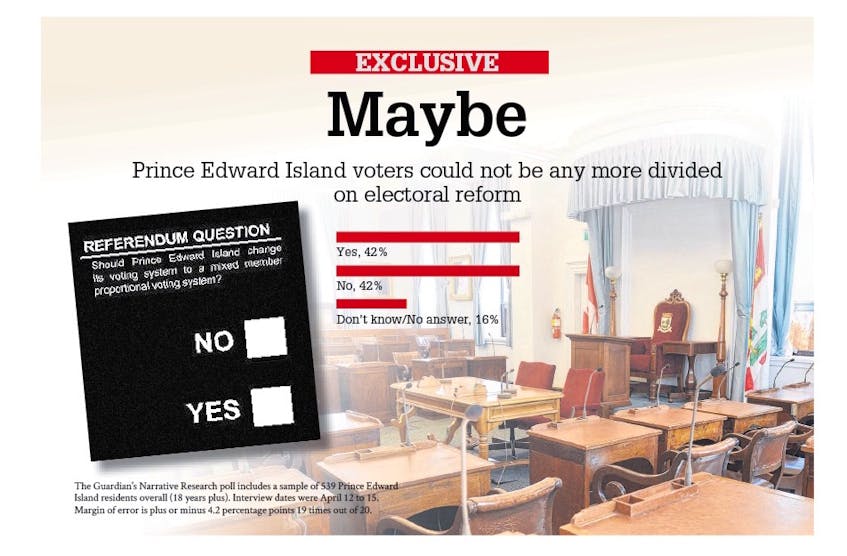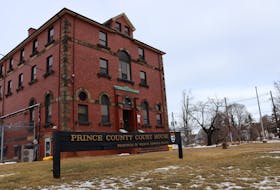This is the last of our stories on polling results leading up to the April 23 election. Click here to view the previous stories on how Islanders say they are voting and the most important issues in this year’s election.
With public opinion evenly split between the yes and no sides, the fate of next Tuesday’s referendum on electoral reform rests squarely with Islanders in the maybe camp.
A poll of 539 Island voters commissioned by The Guardian, conducted by Narrative Research, found that 42 per cent planned to vote Yes in the coming referendum while 42 per cent planned to vote No. The remaining 16 per cent of voters either said they did not know or did not answer.
The referendum asks voters whether the Island should move from a first-past-the-post (FPTP) voting system to a mixed-member proportional (MMP) system. In order for the referendum results to be binding, either side must win a 50+1 per cent majority in 60 per cent, or 16, of the Island’s 27 electoral districts.
When examined by county, support for MMP was highest in Queens County; 46 per cent of voters said they would vote yes while 39 per cent said they would vote no. Fifteen per cent said they were undecided.
In Prince County, 48 per cent of voters supported the no side, 37 per cent supported the yes side and 15 per cent were undecided. In Kings County, 39 per cent supported yes, 36 per cent supporting no and 25 per cent were undecided.
How does MMP work?
- Voters get two votes. One is for a district (or regional) representative, much like what exists in P.E.I. today. Two thirds of the legislative representatives, which would be 18, would be chosen this way.
- The second vote would be for a selection of party candidates. These candidates, who would also campaign, would ultimately win a seat based on the Island-wide proportional party vote in the election. One third of the legislative representatives, nine for the current P.E.I. legislature, would be chosen this way.
Margaret Brigley, president of Narrative Research, said voting intentions on the referendum also broke down along partisan lines.
"We've got 70 per cent of those intending to vote Green saying yes, versus 20 per cent of those intending to vote Liberal saying yes," Brigley said.
Brigley said 33 per cent of PC supporters also supported the Yes side. The sample of NDP voters was too small to accurately gauge voting intentions, she said.
When broken down by age groups, Yes supporters skewed younger, while No supporters tended to be older.
Click here to see all of the polling tables from Narrative Research
Within the 18-34 age group, 51 per cent of voters supported Yes while 28 per cent supported No. For voters aged 35-54, 46 per cent of voters supported Yes, while 36 per cent of voters supported No. For voters aged 55 and older, 34 per cent of voters supported Yes while 54 per cent supported No.
Islanders also seem split based on the issue based upon their level of education. For those with high school education or less, 27 per cent supported Yes, while 51 per cent supported No. For those with some level of post-secondary education, 50 per cent supported Yes while 37 per cent supported No.
The poll has a margin of error of +/- 4.2 percentage points, 19 times out of 20.
How does First Past the Post work?
- First Past the Post, the current system, involves regional 27 electoral districts.
- Voters in each district elect a representative to the legislature from the political party of their choice.
- The party that holds the majority of electoral districts becomes the government.

Both supporters and opponents of mixed member proportional have been running publicly-funded campaigns on the issue. Each received $75,000 from the province to run their campaigns.
John Barrett of No What to Vote says the group has relied on traditional media and flyer mail-outs to reach voters. By Tuesday, No What to Vote will have completed three rounds of flyer mail-outs to over 63,000 voter households. The group has also erected 40 large, billboard-style signs along roadways, has taken out ads in local and regional newspapers and has been running radio and TV ads on Ocean 100 and CBC TV.
Barrett estimated the group spent around $800 on Facebook and web advertising. The group has also avoided sending canvassers to the homes of voters.
"We felt that people were getting door-to-doored enough with three, four and even five candidates in some ridings,” Barrett said.
Brenda Oslawsky of Vote Yes P.E.I. said her campaign has relied more on direct interactions with voters as well as an active social media presence.
Oslawsky said the Vote Yes campaign has sent out only one round of flyer mail-outs to every household in the province. The group has also printed 300 lawn signs and set up 60 larger highway signs. The group has been running ads in regional and community newspapers, as well as on Ocean 100 and CBC TV.
The group’s Facebook page indicates it has conducted door-knocking in 11 different communities. The group has a volunteer base of around 40, Oslawsky said.
Oslawsky said the group has spent $5,000 on web and social media advertising.
"We know that, especially in reaching voters under the age of 55, especially even 45, (social media is) really critical. We know that Doug Ford won the last Ontario election based in a large campaign on his social media campaign," Oslawsky said.
A third group, PRonPEI has not received provincial funding, unlike the official Yes and No groups. This group, which supports a Yes vote, has raised over $5,500 from personal donations and has been running its own TV and radio ads, as well as a Facebook campaign.
Should Prince Edward Island change its voting system to a mixed member proportional voting system?
On the No side:
- Minority governments would be weaker and more unstable
- More power in the hands of political parties and less in the hands of local voters
- Rural ridings could lose democratic representation; ridings would be fewer and larger
- Narrow, single-interest parties could proliferate on P.E.I.
On the Yes side:
- The percentage of votes by party would equal the percentage of seats in the legislature
- Fewer lopsided majority governments; 40 per cent public support would equal 40 per cent of seats in the legislature.
- More diversity of political parties, viewpoints and ideology in government
- Minority governments would foster a cooperative, coalition-oriented political culture
Source: Based on information obtained from the Vote Yes P.E.I. and No What to Vote websites
RELATED









